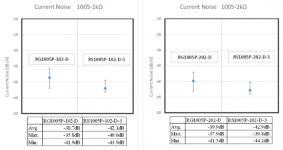Absolutely zero effect? No. Who claims that - some figment of the true believer's imagination?TurboTR said:The comedians taking pot shots at the thought of a resistor having any sonic impact. Funny, sure, but do you really believe that a microvolts/microamps level signal can pass through a component like that and it have absolutely zero effect on it? Zero point zero impact on the travelling wave as it transitions from one conducting medium and dielectric to the next, encounters TC and self heating, vibratory effects, etc, etc. Really, is that possible? No impact? If you believe so you're not paying close enough attention (yet).
Effectively zero effect, for almost all practical audio purposes? Yes, of course - assuming the resistor is not faulty.
Engineering tells us which circuit positions are likely to be sensitive to resistor quality. Engineering also tells us which resistors (or circuit tricks) to use to cope with the issues - although ignoring the issue is unlikely to be audible.
What sort of "travelling wave" are you talking about in a resistor? EM or de Broglie? Could you outline for us the relevant solution to Maxwell's equations or Schrodinger's equation?
Further, there are many more sensitive analogue applications that suffer more vibration, temperature variations etc. than are found in a domestic listening environment, where all these things are factored in (that is what engineering is about) so they have nil effect on the signal once it has passed through a piece of circuitry... Maybe a look at what LIGO is achieving will help you put your fears/beliefs into perspective, just to name one instance of sensitive analogue...
just ignore marce & co ,can't hear difference
What a nice new set of clothes the emperor is wearing...
There is no difference that can be heard the levels are that low, get real mate and stop fantasising, do some proper controlled blind listening tests and you'll find your deluding yourself a lot of the time...
No they cant though that's just it, its sighted perception you are fooling yourself. Try some proper double blind testing you'll find a lot of what you perceive sighted disappears, also the physics and maths does not back you up...
Its yourself you should be feeling sorry for, you still think the emperor has a nice new suit, you are allowing your senses to fool you, without any proper testing or understanding...
Its yourself you should be feeling sorry for, you still think the emperor has a nice new suit, you are allowing your senses to fool you, without any proper testing or understanding...
Tepro RA: a new audio resistor
There's a new resistor made for audio: Tepro RA
It's non magnetic and TCR is 25ppm
http://www.partsconnexion.com/prod_pdf/teproRA.pdf
Seems to be very good according to Jeff's Place and Shirokazu Yazaki
There's a new resistor made for audio: Tepro RA
It's non magnetic and TCR is 25ppm
http://www.partsconnexion.com/prod_pdf/teproRA.pdf
Seems to be very good according to Jeff's Place and Shirokazu Yazaki
I have always found that red resistors tend to shift the channel balance to the left side , while blue ones shift to the right.you are completely right, the sound depends on the resistor color. its coloring the sound. blue resistors gove a "cool" sound. if there are rainbow colors on it, ( not depending on the resistors value ) its just heaven sound.

Yes I know, the "datasheet" is rather light on actual data.
They should show at least show some graphs like the new Susumu RS.
That Susumu RS has low noise comparable to the tx2575.
Another comparison of thin film <> thick film
They should show at least show some graphs like the new Susumu RS.
That Susumu RS has low noise comparable to the tx2575.
Another comparison of thin film <> thick film
Attachments
- Status
- This old topic is closed. If you want to reopen this topic, contact a moderator using the "Report Post" button.
- Home
- Design & Build
- Parts
- Takman: a new audio resistor
